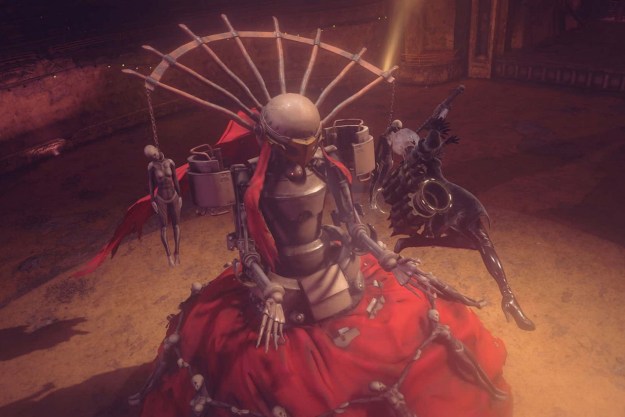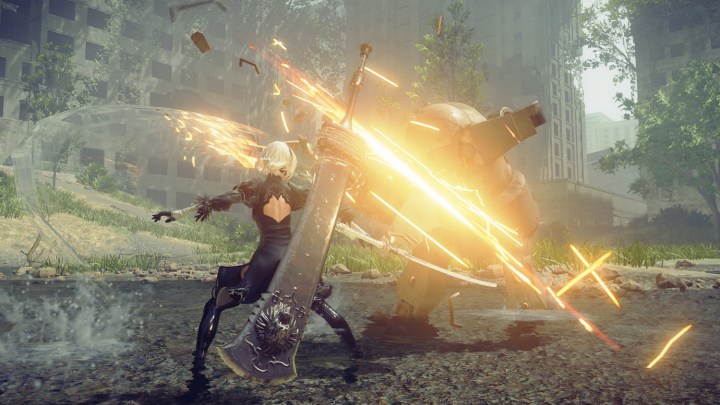
“'NieR: Automata' surprised us as a smart action RPG with a philosophical heart that continually reinvents itself.”
- Unique blend of action, RPG, and shoot ‘em up mechanics
- Thematically and philosophically interesting
- Creative upgrade and unlock systems
- Great soundtrack
- Jack of many mechanics, master of none
- Visuals become quite dull in sections
To the uninitiated, NieR: Automata looks like it was made to sit on game store shelf. At first glance, it reads as a po-faced open-world action role-playing game where an unnecessarily-sexualized female android fights rusted, brown robots in rusted, brown factories. If you dig into the game, however, that uninspiring first impression gives way to, revealing a game brimming with ideas and charm. Combining the action chops of developer Platinum Games with the veteran RPG-making hand of publisher Square Enix, auteur director Yoko Taro’s mad vision has made NieR: Automata one of the strangest and most interesting games we’ve played in years.
While Automata does share the same post-apocalyptic timeline as the original NieR, a last-gen cult hit made by developer Cavia, it is set thousands of years in the future, so no series knowledge is required (though fans of NieR and the Drakengard series from which it spun off will find plenty of references to reward their investment).
Aliens invaded in the distant past, nearly wiping humanity out with armies of robots and forcing the survivors to retreat to the moon. From there the remaining humans wage a proxy war to retake Earth by sending down weaponized androids through the “YoRHa” program. The story focuses on YoRHa combat unit 2B and her partner, reconnaissance specialist model 9S, as they fight to beat back the robot invaders.
Automata’s world is also frequently quite lovely. Ranging from desert and forest environments to a ruined city and amusement park, there’s a compelling melancholy to NieR’s post-apocalypse, which is also reflected in its fantastic orchestral soundtrack. The retrofuturist, toy-like simplicity of the robots belies a great deal of charm. Sometimes, however, their rusty monochrome, combined with the muted environments, occasional camera wonkiness on corners and walls, and the similar design of the main characters, can lead to minor legibility issues in heated battles.
While charming, the visual style often resorts to clichés. 2B is a protagonist very much in the model of Platinum Games’ own Bayonetta: a no-nonsense, high femme, ass-kicking machine–literally, in 2B’s case. While the camera is not nearly as proactively lascivious as in Bayonetta, 2B’s short-skirted, gothic schoolgirl outfit feels out of place in the world, and may turn off some players who are sensitive to women’s objectification.
Nuts and bolts
Fans of Platinum’s past work will know to expect slick, pulse-pounding, combo-driven, third-person brawling, and Automata delivers on that count (if perhaps a little rougher around the edges at times than the studio’s most polished titles). 2B wields two melee weapons at a time, one each assigned to her light and heavy attacks. She also has a small drone hovering by her shoulder, called a pod, which supplements the carnage with and endless supply of bullets and programs (effectively spells on cooldowns).
Though this is the game’s primary mode, the game frequently veers into other gameplay styles. While much the game is played in standard, free camera third-person, it frequently shifts perspective into either a side-scrolling platformer or a top-down “shmup,” with the pod’s ranged attack serving to smooth the genre transition.
The game opens, for example, as a top-down, arcade-style shoot ‘em up. It’s an odd blend of mechanics that works surprisingly well. All enemy projectiles are large, relatively slow-moving spheres, which allows the combat to draw as much from bullet hell games as from 3D brawlers.
Cleverness seems to be built into Automata’s DNA.
Changing up the perspective situationally alters the flow and feeling of combat, and is just one of the many ways that Automata keeps you from getting complacent well into the game.
The action is supported by relatively standard action RPG accouterments such as experience, loot, healing items, etc. All of the game’s many weapons, including the ones 2B starts out with, can be upgraded for endgame viability, so choosing your gear comes down a matter of fighting style than min-maxing a stream of ongoing upgrades. Farming for crafting materials to upgrade everything can be a chore, but gameplay generally hums along at a brisk clip without getting too bogged down by logistics. 2B upgrades her skills by slotting chips into her finite (but expandable) memory to provide buffs like increased weapon damage, or brief invincibility after taking damage.
This same memory system also includes UI features, such as your minimap, health bar, or even the capacity to fade interface elements in and out. The game rewards you for removing extraneous information with marginally more memory with which to buff yourself. With the ability to store three builds at a time, you can easily tailor your skills for your circumstances, such as a Boss-mode profile, which removes exploration-focused features like the map and objectives so you can squeeze in more power for challenging fights. Using 2B’s android nature to justify this sort of fourth wall play by working its UI and menus into the narrative is extremely clever, and that cleverness seems to be built into Automata’s DNA.

Chips also factor ingeniously into Automata’s modular difficulty settings. At any time the player can adjust the difficulty up or down with expected effect like changing how powerful enemies are. At easy difficulty, however, the player also has access to a set of 1 memory chips that can automate combat functions, such as attacking, dodging, or changing weapons. This provides a range of options from automating everything so it’s a breezy button-masher, to just a minor tweak to help get you through a particularly tough fight. The game has a very high skill cap for lightning-thumbed combo wizards, but does a great job of making itself accessible to players who prefer to focus on its twisty narrative.
2B (or not 2B)
Contrasting the visceral brawling of its core gameplay, Automata makes very clear from its opening lines musing about life and purpose that it has a philosopher’s heart. At first, this can feel a bit broad and on the nose, with robot characters called Pascal and Jean-Paul and its cheekily-named protagonist. In a long sci-fi tradition including the likes of Battlestar Galactica and Blade Runner, android and robot stories provide ample opportunities for existential musings, and Automata doesn’t shy away from well-worn tropes. To the game’s credit, however, its characters and ideas do find much more depth as it continues.
The YoRHa exist solely to fight and die on humanity’s behalf, while the robots they hunt similarly exist only to battle for absent creators. After millennia of no progress in this proxy war, and without input from either of the two ostensibly primary parties, the war has become less of a dynamic conflict and almost calcified into a sort of religion. Discovering the world of robots and androids that has evolved in this vacuum is one of Automata’s greatest pleasures.
2B is… a no-nonsense, high femme, ass-kicking machine–literally.
Many of the game’s most interesting scenes, characters, and themes don’t even come to light on your first play through. Like its predecessor and the Drakengard series, Automata features multiple endings that can only be reached through subsequent playthroughs on the same file (retaining items, upgrades, and completed side quests). Reaching the “real” ending actually takes three loops through the game. Far from a chore, however, this has turned out to be one of its most compelling features. The game actually changes quite substantially on subsequent plays. While the first round you play as 2B, for the second loop you play as 9S, who can only carry one weapon but has a new ability to hack things. In addition to providing a new perspective on familiar action, the game also starts inserting interstitial scenes of robot life throughout the past few centuries, layering on new depth and context for the world and fleshing out the game’s subtler themes.
As the industry at large skews toward open-world bloat, filling hundreds of hours with rote fetch quests, NieR: Automata is refreshingly tight. Much of the game’s best character and thematic development actually happens in side quests. Out first play took about 15 hours, with subsequent loops going much more quickly. Like Chrono Trigger, new game plus with a reasonable time to complete the game encourages replay, but NieR takes it to the next level by actually getting stranger and more interesting each time. At the end of our second loop through the game we’d only even seen 84% of its tutorials.
Our Take
NieR: Automata surprised us. Its mechanical mash-up of third-person brawling and bullet hell hangs together far better than it could, and its philosophical musings and world start broad, but find impressive subtlety and depth. It’s not the most polished action-RPG released even this quarter, but in a crowded genre it manages to be proudly, uniquely itself, standing as proof positive that, decades on, Japanese RPGs can be just as smart and as interesting as ever.
Is there a better alternative?
There are countless action-RPGs to suit every taste, but nothing quite compares to NieR’s unique blend of mechanics and ideas.
How long will it last?
Our first time through took roughly 15 hours and 30 to get through the “real” ending, but even then there was plenty left to do, including two more endings to earn by playing the game for the second and third time.
Should you buy it?
Yes. NieR: Automata caught us off guard with how much we enjoyed it and thought about it. Fans of smart philosophical stories, experimental genre-bending mechanics, and Japanese RPGs will all find a lot to like.







